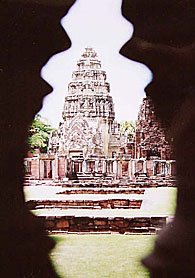On my to-do list
Thailand: Khmer chameleon - by Sharon Stephenson (New Zealand Herald)
Think Thailand, and the bustling mayhem of Bangkok comes to mind. However, an hour's flight north of the capital you find yourself in the calmer, more secluded enclave of Ubon Ratchathani in Thailand's Isan province. Isan is bordered by Laos and Cambodia on three sides, so if you were to do a foxtrot and step right, you'd be in Laos, backwards and you'd hit Cambodia. Not surprisingly, the food, language and silk weaving are heavily influenced by these close neighbours. But what wins me over is the temperature - a glorious 35C that wallops me in the face like a large hot towel as soon as I step out of the airport.
Being this close to Cambodia also means we're surrounded by some of the Khmer people's greatest legacies, and at times it feels as though we can barely move for tripping over Angkor-style temples hewn out of hunks of ancient rock. Perhaps the best example of this is the Phimai Historical Park, Thailand's largest Khmer historical site believed to have been built in the 12th century. It's striking that this sprawling temple combines both Hindu and Buddhist sensibilities and the ornately carved sandstone with its unusual pink hue keeps us mesmerised for hours. We're finally driven away by the midges - and this despite the industrial strength insecticide we almost marinate in before leaving the hotel.
Thankfully, the Phimai National Museum seems to be an insect-free zone. Set on the banks of the beautiful Mun River, the museum contains rooms of artefacts, including the rudimentary objects used to construct the Khmer temples. What catches my eye, though, is the bling: ornate shell, stone and glass beads from the Bronze and Iron Ages (3000-1500 years ago), which prove women from all cultures throughout history have had a love affair with shiny baubles. Save your ticket from the historical park because it'll guarantee you entry to the museum for a month. The next day is also filled with temples, but this time we're in the sticks. The first is Phanom Rung, a 1000-year-old Khmer site that sits on an extinct volcano. It began life as a Hindu religious site and the building's layout was determined by Hindu god Shiva's image of heaven. After a short drive though bush we arrive at Muang Tam, where an impressive collection of sandstone pagodas again reflects the temple's Hindu origins. I feel as though I've hit my temple limit for the day. It's time to turn our attention to the other star attractions of northern Thailand - elephants.
These graceful creatures have played an integral part in Siamese or Thai life - Siamese soldiers rode elephants into battle, and later the majestic beasts were used in the logging industry. But when that was banned in 1989, thousands of domestic elephants suddenly found themselves unemployed and unable to fend for themselves. Many, thankfully, now live at the Surin Elephant Centre, the world's largest elephant village. Here the Suai people, who've raised elephants the traditional way for generations, look after a seemingly endless number of this protected species. They also run elephant "talent shows", where their charges perform unnatural tasks as kneeling down and throwing darts. That's not going to appeal to everyone but you can have as much, probably more, fun by spending a few baht on a bunch of bananas and hand-feeding the rough-skinned giants.
If you have time, head up the road to the Ban Tha Sawang silk-weaving village where master craftsmen and women work traditional looms to produce exquisite woven cloth. Afterwards, we wander the many stalls picking up ridiculously cheap silk scarves, table cloths and handbags. Isan may not be on everyone's "places to visit before I die" list, but as an alternative to Bangkok - and for a genuine glimpse into how these gentle and welcoming people live - it ticks all the right boxes. Sharon Stephenson was a guest of The Tourism Authority of Thailand and Thai Airways.
Labels: Isaan, Northeast Thailand


